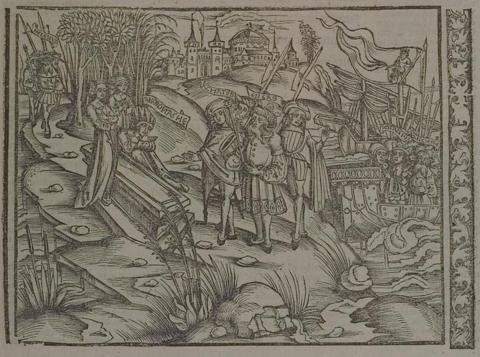Annotations
Aeneas and his people have landed at Buthrotum, a city in Epirus, ruled by Helenus, a son of Priam (292-5). Andromache sits in a grove near the city grieving beside the Tomb of Hector, an empty tomb set up in honor of her late husband (304). Vergil describes the tomb as a green mound with two altars; instead, Andromache lies next to either a double-sized altar or a casket-sized monument. In the taxt, Andromache and her attendants offer a ritual feast and gifts to the ghost of Hector (301-4); in the image, it is difficult to see if any of the three women are holding anything in their arms, but it appears that they hold nothing. The water on the left could possibly be the "false Simois" river that Vergil mentions in line 302. Aeneas and a small retinue approach Andromache, leaving the majority of his people, including Anchises and Ascanius, on the ships (300; 306-7). Andromache, seeing Trojan arms, speaks to Aeneas, and they begin an exchange (310-43) that is cut short when Helenus enters the scene and invites them up to the city (344-8). (Katy Purington)
Woodcut illustration from the “Strasbourg Vergil,” edited by Sebastian Brant: Publii Virgilii Maronis Opera cum quinque vulgatis commentariis expolitissimisque figuris atque imaginibus nuper per Sebastianum Brant superadditis (Strasbourg: Johannis Grieninger, 1502), fol. 195r, executed by an anonymous engraver under the direction of Brant.


Sebastian Brant (1458–1521) was a humanist scholar of many competencies. Trained in classics and law at the University of Basel, Brant later lectured in jurisprudence there and practiced law in his native city of Strasbourg. While his satirical poem Das Narrenschiff won him considerable standing as a writer, his role in the transmission of Virgil to the Renaissance was at least as important. In 1502 he and Strasbourg printer Johannes Grüninger produced a major edition of Virgil’s works, along with Donatus’ Life and the commentaries of Servius, Landino, and Calderini, with more than two hundred woodcut illustrations. (Annabel Patterson)